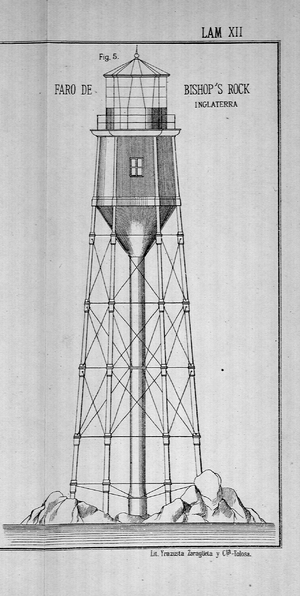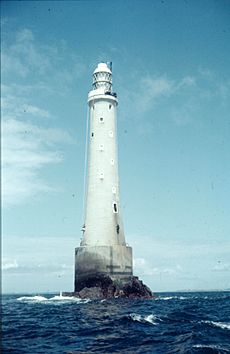Bishop Rock, Isles of Scilly facts for kids
The Bishop Rock (which means Men Epskop in Cornish) is a tiny rock off the British coast in the northern Atlantic Ocean. It's famous for its amazing lighthouse. This rock is the westernmost part of the Isles of Scilly, a group of islands about 45 km (28 mi) off the southwestern tip of Cornwall. The Guinness World Records even calls it the world's smallest island with a building on it!
The first lighthouse started in 1847 was made of iron. But a big storm washed it away before it was finished. The lighthouse you see today was completed in 1858. Its light first shone on 1 September that year. Before a helipad was added, visitors had to rappel (climb down ropes) from the top to reach boats below.
Bishop Rock was also the eastern end of an important shipping route. This route was used by huge ocean liners in the early 1900s. They would race across the Atlantic for the Blue Riband award.
Contents
History of Bishop Rock
The rock was first called Maen Escop in 1284. In the Cornish language, Men Eskop means "Bishop's Stone." Some people think the rock looks like a bishop's special hat, called a mitre.
East of Bishop Rock are the Western Rocks. Here, a famous ship called HMS Association was wrecked in 1707. This was part of a huge naval disaster.
Shipwrecks Near Bishop Rock
The first recorded shipwreck right on Bishop Rock was in 1839. A ship called Theodorick hit the rock in foggy weather. In 1842, a large paddle steamer named Brigand also struck the rock. It hit so hard that it broke its front plates. The ship then spun around and damaged its paddle-wheel. It drifted for a while before sinking. Luckily, all the crew were saved. In 1901, a sailing ship called Falkland hit the rock. Its main mast even struck the lighthouse itself!
The Bishop Rock Lighthouse
| Year first lit | 1887 (rebuilt) |
|---|---|
| Tower shape | tapered cylindrical tower with lantern and helipad on the top |
| Markings / pattern | unpainted tower, white lantern |
| Original lens | Hyperradiant Fresnel 1330 mm Rotating |
In 1818, people realized how dangerous Bishop Rock was for ships. They suggested building a lighthouse there, like the Eddystone Lighthouse. The government thought about it, and an engineer named John Rennie the Elder even offered to build it. But the government didn't take his offer.
Later, in 1843, Trinity House (the group in charge of lighthouses) surveyed the rock. Work on a lighthouse began in 1847. The chief engineer, James Walker, planned a 37-meter (120 ft) tall lighthouse. It would have living spaces and a light on top of iron legs. But this first attempt failed. On 5 February 1850, a big storm washed the entire tower away.
Building the Stone Lighthouse
For the second attempt, James Walker started building a stone lighthouse in 1851. Building on the rock was very hard. There wasn't much space, and the rock was sloped. This meant the first stones had to be placed below the lowest tide level.
Despite many challenges, the tower was finished without anyone losing their life. It was fitted with a large first order light. This light shone for the first time on 1 September 1858. The lighthouse cost £34,559 to build.
However, the lighthouse faced the full power of the Atlantic Ocean. In bad weather, the tower would shake a lot. The vibrations were so strong that things would fall off shelves. Even the light's equipment would sometimes break. The lighthouse originally had a fog bell, but a storm washed it away in 1860. A bigger bell was added later in 1864.
Renovating the Lighthouse
In 1881, Sir James N. Douglass checked the tower. He designed a plan to make it stronger. This involved adding huge granite blocks to the rock and connecting them to the lighthouse. These renovations also made the lighthouse 12 meters (40 ft) taller. The work started in 1882 and finished in 1887.
The improved light could be seen from about 34 kilometers (18.25 nautical miles) away. The new light system was very advanced. It had two identical lamps and lens sets, one above the other. Each set used a powerful paraffin burner. It also had special hyperradiant Fresnel lenses that made two white flashes every minute. In clear weather, only the bottom light was used. In foggy weather, both lights were used at full power.
A small air engine turned the heavy light system. Compressed air for this engine came from tanks below. These tanks were filled by engines that also used compressed air. This compressed air could also power a small winch to bring supplies to the lighthouse.
As part of the renovation, an explosive fog signal was added. In foggy weather, the keepers would attach a special charge to a crane-like arm. They would then raise the arm and fire the charge electrically from inside the lighthouse. This explosive signal was used until 1976.
The Lighthouse Today
The paraffin lamps were used until 1973. That's when the light was changed to run on electricity. It was hard to reach the lighthouse by boat. So, in 1976, Trinity House built a helipad on top of the lighthouse. In the same year, a powerful fog horn was installed.
On 15 December 1992, the lighthouse became fully automated. This means no keepers live there anymore. The bottom half of the old light system is still used. But the top half was removed and is now on display at the National Maritime Museum Cornwall. An electric fog signal replaced the old horn. It sounded a long and then a short tone every 90 seconds. This signal was stopped in 2007.
On 5 February 1994, a storm badly damaged the metal entry doors. These doors had to be replaced. They are now also on display at the National Maritime Museum Cornwall in Falmouth.
Lighthouse Structure and Cost
Bishop Rock Lighthouse is often called the "King of the lighthouses." It is a very impressive building. At 49 meters (161 ft) tall, it is one of the tallest lighthouses in England, just like Eddystone Lighthouse.
Building the lighthouses at Bishop Rock cost a lot of money:
- The first iron lighthouse: £12,500
- The second granite lighthouse: £34,559
- The third improved lighthouse: £64,889
- The total cost was £111,948.
Inside the lighthouse, there are 10 floors. A spiral staircase goes up to the second floor. From there, a metal door leads to an outside ladder that goes down to the large base of the lighthouse. Another metal ladder from the base leads to a stone staircase down to the water.
Here's what each floor was used for:
- 1st floor – Water tank (for fresh water)
- 2nd floor – Entrance room with the metal door
- 3rd floor – Store room
- 4th floor – First oil room (for lamp oil)
- 5th floor – Second oil room
- 6th floor – Living room for keepers
- 7th floor – Bedroom for keepers
- 8th floor – Store room
- 9th floor – Service room
- 10th floor – Lamp (where the light shines from)
Culture and Media
Bishop Rock is the subject of a short orchestral music piece. It was written by Doreen Carwithen.
The lighthouse has been used as a filming location for TV shows. It appeared in a BBC One Ident. It was also shown in the documentary series Three Men in More Than One Boat. In 2010, it was featured in the BBC documentary Islands of Britain.
In 1975, the lighthouse was on the children's TV show Blue Peter. Presenter Lesley Judd visited it. She had a scary moment when her safety harness snapped while she was traveling by rope to the lighthouse from a boat!
The lighthouse also appears in books. It's in the novel Stone In The Blood by Colin Jordan and David England. It's also in the short story "Keeper of the Bishop" by A E W Mason.
Images for kids
See also
 In Spanish: Bishop Rock para niños
In Spanish: Bishop Rock para niños






